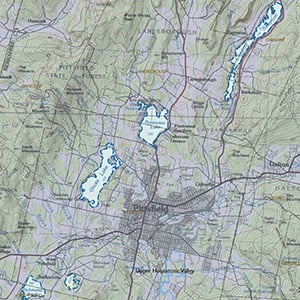Important Bird Area Sites in Massachusetts
Important Bird Area: Central Berkshire Lakes
Site Summary
Nominated By
René Laubach
Size
100 acres
Towns and Counties
Pittsfield, Richmond; Berkshire
Ownership
Mud Pond, Pittsfield, state
Major Habitats
95% lake/pond, 2% emergent freshwater wetland, 1% cultural grassland, 1% palustrine wooded swamp, 1% river/stream
Land Use
hunting/fishing, recreation
Serious Threats
invasive plants, recreation development, overuse
Minor Threats
water pollution, disturbance to birds
IBA Criteria
- Category 5: Sites important for long-term research and/or monitoring projects that contribute substantially to ornithology, bird conservation, and/or education.
Site Description
Five major lakes/reservoirs and one smaller water body (Mud Pond) are situated in the Berkshires' central valley. The six (from north to south) are Hoosic Lake (500 acres) in Cheshire (aka Cheshire Reservoir), Pontoosuc Lake (470 acres) in Lanesborough and Pittsfield, Onota Lake (617 acres) in Pittsfield, Mud Pond/Marsh (100 acres) in Richmond, Richmond Pond (217 acres) in Pittsfield and Richmond, and Stockbridge Bowl (372 acres) in Stockbridge. These lakes annually host considerable species of geese, ducks, loons, grebes, coots, gulls, and other water-loving species of birds during migration, especially fall. A combined total of at least 32 species of swans, geese, and ducks have been found on these lakes, as well as 3 species of loons, 3 species of grebes, the Double-crested Cormorant, and the American Coot. The lakes represent an important stopover point for waterfowl migrating along the Housatonic River valley. In 1946 the late Bartlett Hendricks and the Hoffmann Bird Club inaugurated an annual waterfowl census of these lakes (and other smaller water bodies south to the town of Sheffield) that continues to this day. Significant numbers of geese, dabbling ducks, diving ducks, loons, and grebes are counted annually. There have also been many records of species that are considered rare or casual in western New England. Among these are King Eider (1993), Pacific Loon (1964, 1985), Parasitic Jaeger (1970), Greater White-fronted Goose (1991), Barrow's Goldeneye, (1946, 1984), Wilson's Storm-Petrel (1985), Leach's Storm-Petrel (1985), Franklin's Gull (1997), Little Gull (1946), 2 Black-legged Kittiwakes (1997), and Lesser Black-backed Gull (1992, 1996). In addition, associated marshlands provide breeding habitat for locally uncommon marsh birds such as the Marsh Wren.
Current Conservation Status
Residential development around nearly all of the lakes is quite extensive, and the problems caused by leaky septic systems, lawn fertilizer, and pesticide runoff, etc. are potentially serious. The lakes are also quite heavily used for fishing and boating, but these recreational uses are very minimal during the migratory periods when waterfowl use the lakes. Some of the lakes (notably Pontoosuc) continue to be drawn down in the fall for weed control. Eurasian Milfoil is quite abundant.
Ornithological Significance
This site provides an important stopover/feeding area for dozens of species of waterfowl in the Housatonic River valley region of western Massachusetts. An extensive cattail marsh along the outlet of Richmond Pond hosts the areas' only breeding population of Marsh Wrens. Censuses have taken place annually in the proposed IBA in early November since 1946, and the information from more than one-half century of observation represents a very valuable data set. In recent years, Mud Pond has been the best location in western Massachusetts to find Ring-necked Ducks during migration. 900+ were counted there in November 2001 (E. Neumeth).
Other Flora or Fauna of Significance
Town Brook, which empties into Pontoosuc Lake at its northern end, is the only place is the Commonwealth where all three species of trout reproduce; of course only Brook Trout are native. Sizable bat maternity colonies, especially of the Little Brown Bat, are located in close proximity to these lakes. The non-native Mud Puppy has been found in Stockbridge Bowl.
Data Sources
Hendricks, B. 1999 (Third Edition) Birds of Berkshire County. 75 pp.
1992. Waterfowl in the Berkshires. Bird Observer. pp. 240-244.
1946-2002. Data from Hoffmann Bird Club Waterfowl Counts.
Laubach, R. 1985-2002. Field Notes.




